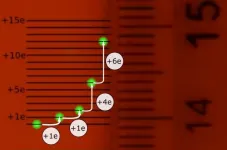The absorption of an individual electrons captured on film
2021-06-17
(Press-News.org) Researchers at the University of Gothenburg have observed the absorption of a single electron by a levitated droplet with such a magnification that it is visible with the naked eye and can even be measured with a normal millimeter scaled ruler.
Matter in the universe is composed of elementary particles like electrons, protons, and neutrons. They are everywhere, but they are so small that the human eye cannot discern them. In the last century, physicists have proven the existence of these particles through different experiments, but in most cases the observation of the particles have been indirect.
- Electrons are one of these fundamental particles. In 1909, Robert Millikan proved that the charge of the electron is quantized. In other words, there exists a minimum, indivisible amount of charge. He demonstrated that the electron´s charge is quantized by letting hundreds of charged droplets fall in an electric field and then perform a statistical analysis of their motion.
An experiment with a single levitated drop
-Now we have created a modern version of this classical experiment by levitating a single droplet in air using a laser, says Javier Marmolejo, Ph.D. at the Department of physics at the University of Gothenburg.
In this experiment, the quantization of the electric charge is directly visible for the first time without advanced equipment or a complex statistical analysis.
- We trapped a drop using a laser inside a strong electric field and added individual electrons by exposing it to alfa radiation. The drop performed quantized jumps every time it absorbed one or a few electrons. By magnifying the image of the droplet using a single lens, we were able to see the effect of a single electron absorption and to measure the jumps with a ruler. The bright spot moved about one millimeter for every absorbed electron (see video).
The drop had a diameter of 29 micrometers, which roughly corresponds to the thickness of a thin human hair. Despite this, it contains around 3.7 x1015 negatively charged electrons.
- The feat is incredible when one considers that the effect of adding single electron to a droplet that already has 3 700 000 000 000 000 is visible with the naked eye.
Now that it is possible to "see the effect of a single electron", a new opportunity emerges to better communicate science regarding elementary particles to the general public, the researchers comment.
INFORMATION:
Contact:
Javier Tello Marmolejo, doctoral student, Department of Physics, University of Gothenburg, e-mail. javier.marmolejo@physics.gu.se, phone: 070 017 53 19
Dag Hanstorp, professor, Department of Physics, University of Gothenburg, phone: 0766-22 91 41, 031-786 91 41, e-mail: dag.hanstorp@physics.gu.se
Link to article in Scientific Reports, "Visualizing the electron's quantization with a ruler" : http://www.nature.com/articles/s41598-021-89714-2
Video: Javier Marmolejo
Illustration: Javier Marmolejo
Facts about the experiment
A laser trap was used to levitate a silicone oil droplet in air. The trap consisted of a green laser with a wavelength of 532 nanometers that was directed upwards and focused by a lens with a focal distance of 100 mm. The focal point was placed between two electrodes placed in the center of the experimental chamber. The electrodes were parallel and separated by 1 mm. A 29 micrometer droplet was dropped into the laser beam, where it was trapped. Between the plates, a 666 V potential difference was applied which created a strong electric field. Alfa radiation was directed towards the almost uncharged droplet, ionizing the air around it. When the droplet gained or lost charge, the force applied by the electric field changed which in turn changed its position. The effects were magnified 73 times by a lens and projected onto a wall. With this magnification, the micrometric movements of the drop were observable with the naked eye. A common millimeter ruler was placed on the wall where the researchers could directly observe the number of electrons the drop gained as it jumped about 1 mm per added electron.
[Attachments] See images for this press release:

ELSE PRESS RELEASES FROM THIS DATE:
2021-06-17
Researchers from Skoltech and Saratov State University have designed a simple and easily reproducible labeling system for individual cells that enables researchers to track single cell behavior and migration for tasks requiring extreme precision. The paper was published in the journal ACS Applied Materials and Interfaces.
Modern biomedical science and developmental biology often require scientists to track and trace individual cells, whether it is to establish the best purified cells from various types of cell lines, in particular to select mesenchymal stem/stromal cells best suited for tissue ...
2021-06-17
The production of chemicals is a cumbersome business. Often, only a small part of what is actually wanted is produced in the factory. The large remainder is unusable - or even worse. Examples? The defoliant "Agent Orange" used by the US army in the Vietnam War was produced in great hurry. It contained dioxin as an impurity. As a result, not only did trees in the combat zone lose their foliage, but US soldiers and Vietnamese civilians also fell ill with cancer years later.
There are also examples from agriculture: In the production of the insecticide lindane, ...
2021-06-17
As a new member of photovoltaic family, antimony trisulfide (Sb2S3) has the satisfactory bandgap of 1.7eV, benefiting the fabrication of the top absorber layer of tandem solar cells. Due to special quasi-one-dimensional structure, it shows advantages of less dangling bonds. Based on these advantages, the vacancy defects upon the surface causing the recombination of the carriers could be reduced sharply, which helps to solve the photovoltaic problems in solar cells.
In the previous studies, the relationships between conformation, chemical composition and ...
2021-06-17
Scientists have developed a new method that improves dispensing of viscoelastic fluids - a vital process for circuit board production, 3D printing and other industrial applications
Viscoelastic fluids are difficult to dispense as liquid bridges that form between the substrate and nozzle must be broken
New research has found that twisting these liquid bridges breaks them in a quicker and cleaner way than the conventional method of stretching them
Researchers used high speed imaging to observe that when twisted, a crack forms at the edge of the liquid bridge and propagates towards the center
The underlying mechanism that breaks the liquid bridge was found to be "edge fracture" and is the first time that ...
2021-06-17
During flock encounters, a single vocal interaction seems to be sufficient for making the decision of whether to recruit an individual or flock. Parrots are known for their splendid ability to imitate, including the contact calls of other individuals during vocal interactions. Such rapid vocal matching is hypothesised to precede and mediate the formation of new flocks. But how are such interactions perceived by others?
Heidi M. Thomsen, first author and PhD student at the Department of Biology, University of Copenhagen explains:
-"By using a novel experimental design, we were able ...
2021-06-17
Seiichi Shirai (1905-1983) was an influential architect whose work has affected the designs of significant architects of the 20th century. Associate Professor Kosuke Hato of the Department of Architecture, Faculty of Engineering, Shinshu University has studied the work of Shirai and examined why the architect worked extensively on calligraphy. Hato's strategy is to clarify the relationship between the architect and his activity of calligraphy through Shirai's Theory of Tradition.
The 1950s in Japan is known as a time when architects actively discussed traditions, and Shirai is a representative example. Hato, in his past article, clarified not only the ...
2021-06-17
Is it possible to drive nanoparticles to orbit below the light diffraction limit using a Gaussian beam? A recent joint research project reported in Nature Communications says yes.
It is well known that light possesses not only energy but also momentum. When light irradiates an object, momentum is transferred to the object, thus generating light pressure on the object. At the microscopic scale, microparticles and nanoparticles (such as biocells and macromolecules) can be manipulated by the light force. Atoms can be cooled by light pressure to achieve atomic clocks, Bose-Einstein condensation, and so on.
In addition to the linear momentum of light being transferable, the angular momentum of light can also be transferred to an object, thus causing object rotation. Since ...
2021-06-17
Tissue-engineering scaffolds built around ultrashort peptides provide a new platform for studying bone regeneration in the lab.
The peptides developed at KAUST self-assemble into a cartilage-like hydrogel that mimics the natural matrix that underpins bone formation in the body. Its physiologically relevant properties enable this cell-friendly biomaterial to support the growth and development of bone marrow precursor cells. It also enables tubular blood vessels to take shape, which is a critical part of bone health and repair.
"Our system is a simple, efficient and robust model that closely resembles the complex architecture of native bone tissue," says Ph.D. student Salwa Alshehri. "Using these peptide-based ...
2021-06-17
Thousands of years ago, archaic humans such as Neanderthals and Denisovans went extinct. But before that, they interbred with the ancestors of present-day humans, who still to this day carry genetic mutations from the extinct species.
Over 40 percent of the Neanderthal genome is thought to have survived in different present-day humans of non-African descent, but spread out so that any individual genome is only composed of up to two percent Neanderthal material. Some human populations also carry genetic material from Denisovans - a mysterious group of archaic humans that may have lived in Eastern Eurasia and Oceania ...
2021-06-17
A study carried out by the Institute of Environmental Science and Technology of the Universitat Autònoma de Barcelona (ICTA-UAB) and the Instituto de Saúde Pública of the University of Porto (ISPUP), concludes that exposure to natural spaces during the first COVID-19 lockdown in 2020 was beneficial for the mental health of Spanish and Portuguese citizens.
The research shows that, in Portugal, during the first confinement, people who maintained or increased contact with natural public spaces, such as parks and coastal areas, or who could contemplate these spaces from their homes, presented lower levels of stress, psychological distress and psychosomatic symptoms.
In Spain, those who maintained or increased contact with private natural ...
LAST 30 PRESS RELEASES:
[Press-News.org] The absorption of an individual electrons captured on film



